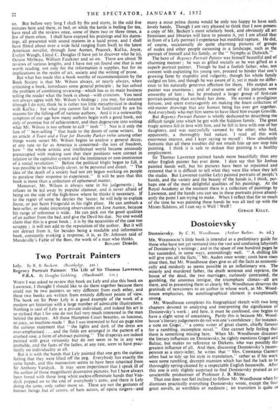Two Portrait Painters
Lely. By R. B. Beckett. (Routkedge. sos.)
Regency Portrait Painter: The Life of Sir Thomas Lawrence, P.R.A. By Douglas Goldring. (Macdonald. 2 s.) WHEN I was asked to review this book on Lely and also this book on Lawrence, I thought I should like to do them together because there could not be two painters so very different from each other, and these two books are written from entirely different points of view. The book on Sir Peter Lely is a good example of the work of a modern art historian with a large number of admirable illustrations. Nothing is said of Lely as a private individual, and indeed his art is so stylised that I for one do not feel very much interested in the man behind the picture. All those Hampton Court beauties, so luscious, so juicy, so machine-made ! But I was interested to find on page nine the curious statement that " the lights and dark of the dress are over-emphasised . . . and the folds are arranged in the pattern of a crushed rose, a form of abstract painting." The draperies are indeed painted with great virtuosity but do not seem to be in any way probable, and the faces of the ladies, at any rate, seem to have prac- tically no individuality at all.
But it is with the hands that Lely painted that one gets the curious feeling that they were lifted off the peg. Everybody has exactly the same hands, and this mannerism seems to have been inherited from Sir Anthony Vandyck. It may seem impertinent that I speak ill of the author of those magnificent decorative pictures, but I have always been bored with those long white useless effeminate hands that Van- dyck popped on to the end of everybody's arms, and there is Lely doing the same, only rather more so. These are not the gestures of human beings .but of actors, of ham actors, of opera singers—and many a stout prima donna would be only too happy to have such lovely hands. Though I am very pleased to think that I now possess a copy of Mr. Beckett's most scholarly book, and obviously all art historians and libraries will have to possess it, yet I am afraid that in front of a Lely portrait I experience but modified rapture. He did, of course, occasionally do quite charming pictures of groups of nudes and other people carousing in a landscape, such as the portrait of himself and his family, or the " Nymphs at Dulwich."
The hero of Regency Portrait Painter was himself beautiful and of charming manner ; he was as gifted socially as he was gifted as a superb portrait painter. Though he had a foolish father, who, not content with exploiting his young son, proceed to hinder that son's growing fame by stupidity and vulgarity, though his whole family cadged on him, and though he was aware of it, yet it made no differ- ence to his naturally generous affection for them. His output as a painter was enormous ; and of course some of his pictures were unworthy of him ; but he produced a larger group of first-rate portrait-painting than anybody has done. He earned a prodigious fortune, and spent extravagantly on making the finest collection of old-master drawings that any human being has ever got together. And everybody who met him seems to have liked him except Greville.
But Regency Portrait Painter is wholly dedicated-to describing the difficult tangle into which he got with the Siddons family. The great tragic actress fell in love with him, and he fell in love with one of her daughters, and was successfully vamped by the other, who had, apparently, a thoroughly bad nature. I read all this with enormous interest, and I kept saying to myself : How absolutely fantastic that all these troubles did not smash him up nor stop him painting. I think it is safe to deduce that painting is a healthy employment.
Sir Thomas Lawrence painted hands more beautifully than any other English painter has ever done. I dare say that Sir Joshua painted hands well, but his pictures have been so repainted and restored that it is difficult to tell what they were like when they left the studio. But Lawrence (unlike Lely) painted portraits of people's hands, and the variety and the beauty of the hands is, I think, per- haps one of the most delightful qualities of his paintings. At the Royal Academy at the moment there is a collection of paintings by Lawrence, and the hands you can see in these portraits prove abund- antly the point I am trying to make. When I reflect that for so much of the time he was painting these hands he was all tied up with the Misses Siddons, all I can say is Well !
GERALD KELLY.






































 Previous page
Previous page